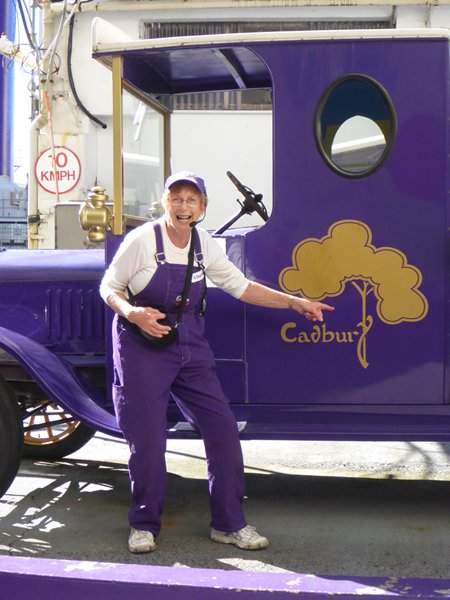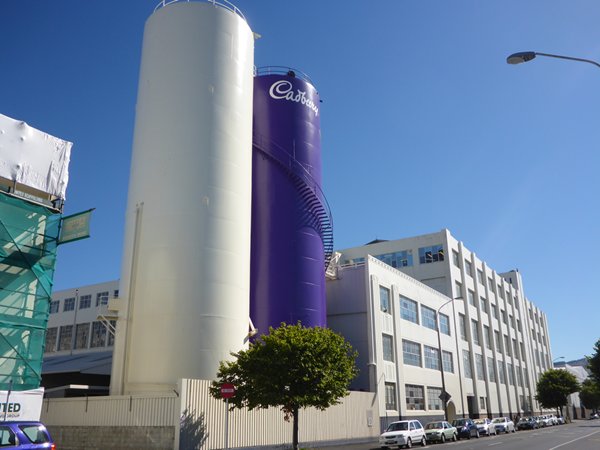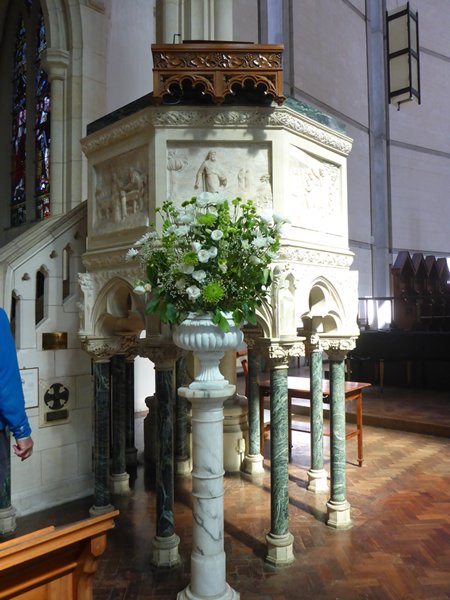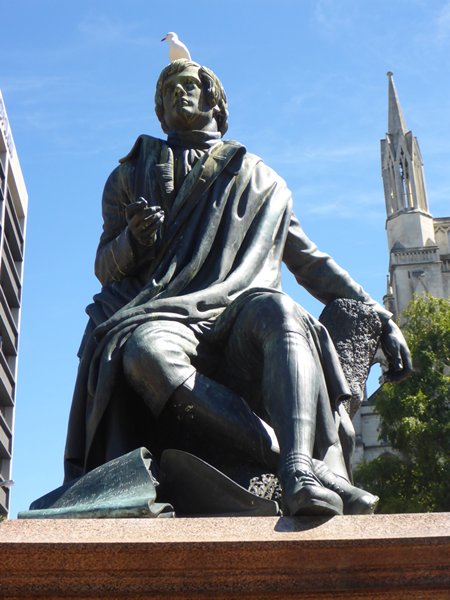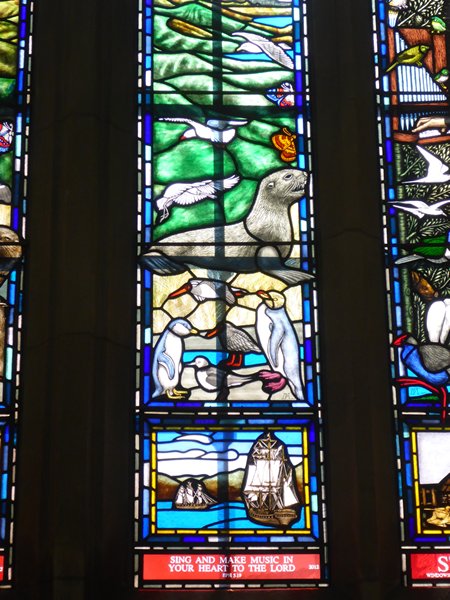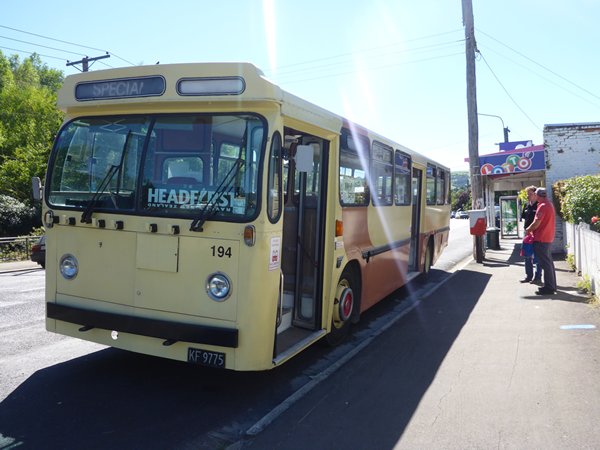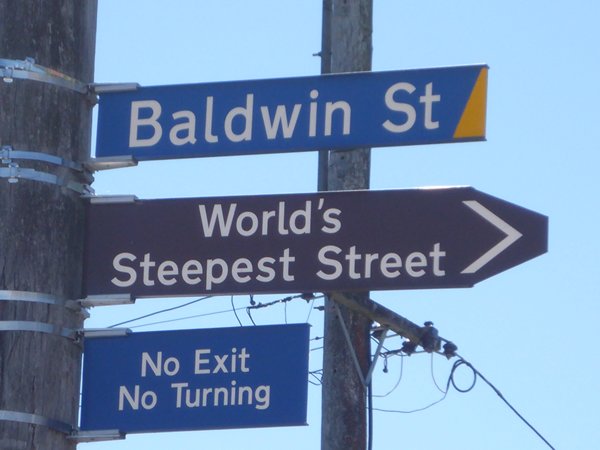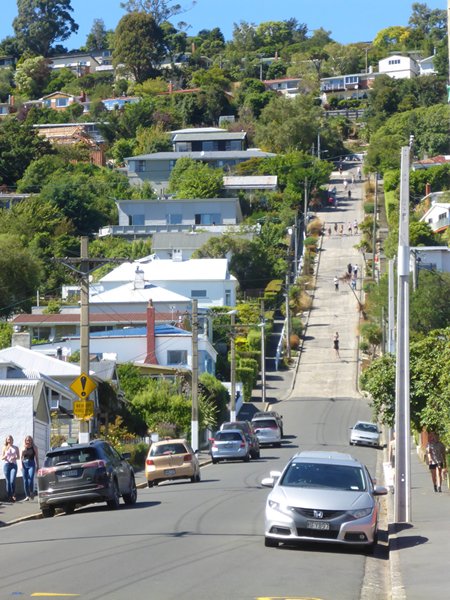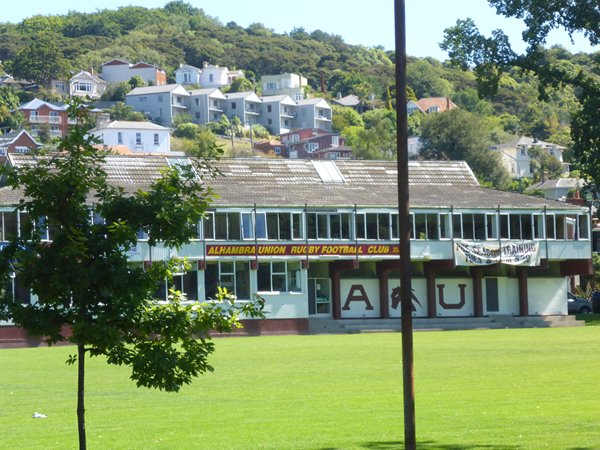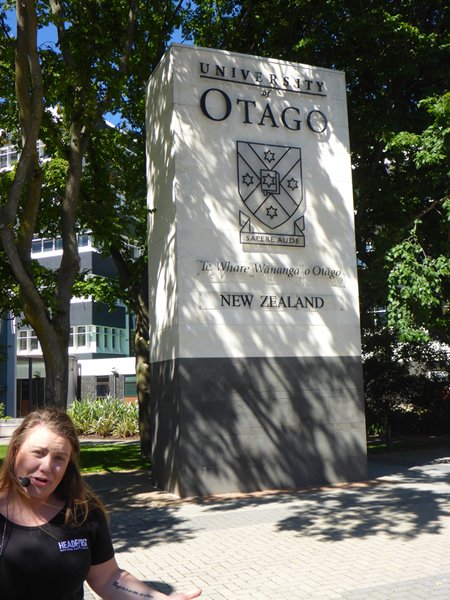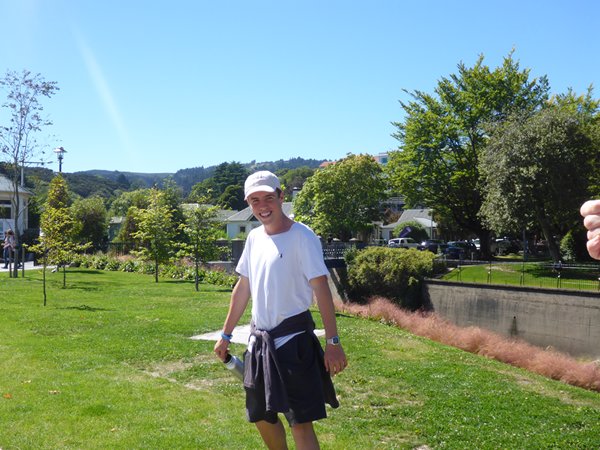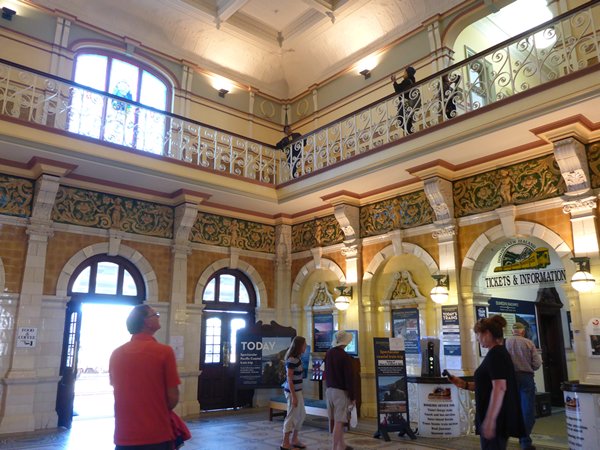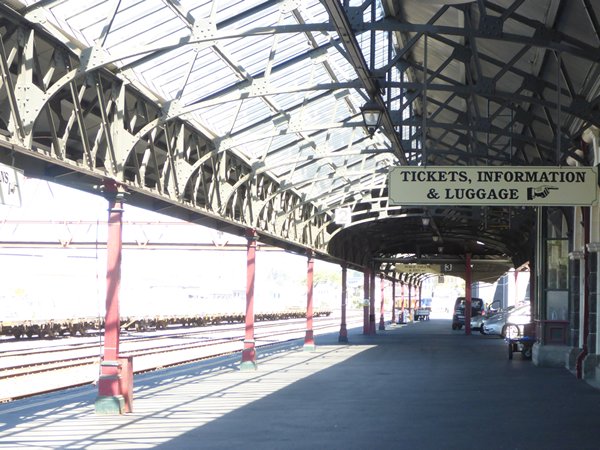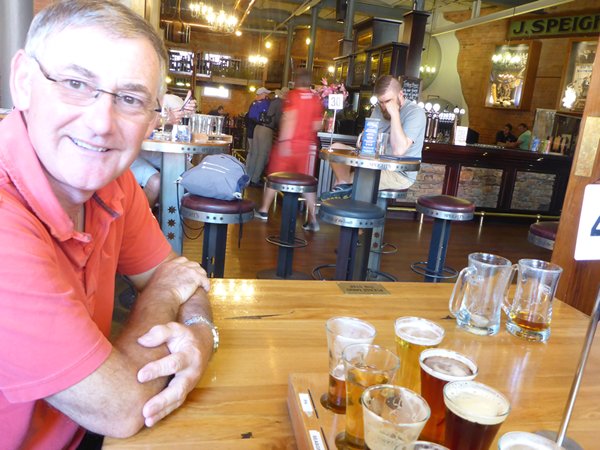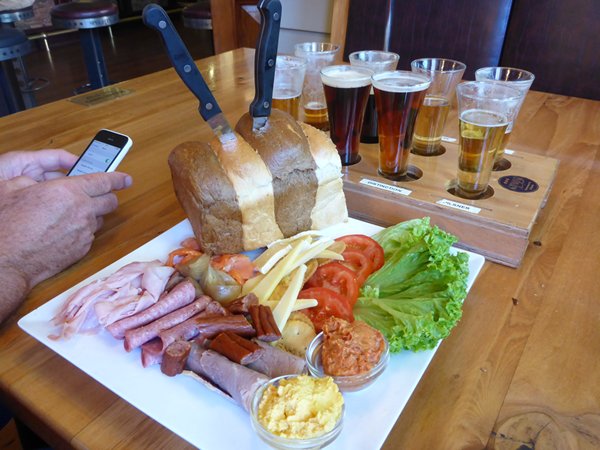Down and out in Dunedin with half pictures

|
Down and Out in Dunedin The little bus almost poured us into one of the chocolate moulds at the Dunedin Cadbury factory it was so handy. The factory which provides hundreds of jobs locally is due to close at the end of the year, but we were assured by our guide, Carol, that the visitor centre would continue. That’s because we, as visitors don’t actually get to see the production part; the delicious pouring of shiny brown, polished chocolate into those choc box medleys of yumminess, or see the uniquely NZ little round bright orange Jaffas being tumbled in their lurid coating or indeed witness the emergence of a thousand perfect Easter Bunnies. But we did get the free chocolate, well my gifts were two big bars of chocolate because everything else they produce contains animal rennet. Plus we climbed the steps into the purple silo to watch a ton of tempered milk chocolate fall from the top to the bottom not for any other reason than our entertainment. Eat your heart out Dawn French, Vicar of Dibley. In the ‘sensory tasting lab’ we made our own chocolate concoction, pouring different flavours from taps on the side of the chocolate train into a little pot to be savoured as we followed Carol around like sheep. The exit cunningly takes us through the shop where queues of our friends from Asia waited to have their bulging carrier bags priced up at a fraction of the shop prices. Others wanted to pose for photos under the sign and metres from their photographer, requiring an empty space for the perfect shot thus holding up the dozens trying to leave. Outside the day was brilliant and hot as we boarded a 1981 beautifully restored Leyland Bus for our Headfirst Tour around the city. The driver was a volunteer who also helps in the restoration and maintenance of their fleet of 10 buses of which 8 are always working. Our guide was the marketing manager of the company. Driving slowly past the Alhambra Rugby Club she explained that mixed teams played naked in mid- winter, I had to do a quick think, which season are we in? Our bus had special low ratio gears on it for the demanding hills of the city, but the ‘steepest hill in the World’ Baldwin Street was one only to be attempted by the healthiest vehicles not these precious babies. We walked up the lowest part to be told the record for running bottom to top and back is 1 minute 58 seconds. Give me a day. The University of Otago was demanding our attention and we chatted with a young student who agreed to pose alongside the Water of Leith. New students are warned to bring woollies and plenty of scarves for the chilly winters, so they are called scarfies. But today they were all in shorts and t shirts. Our final stop was the architecturally beautiful Railway Station which is inside and out the finest train station I have ever seen. The care that has always been lavished on it from the internal loos to the fabulous garden at the front epitomises the civic pride taken in this Heritage capital of NZ. Back on our feet we had a quick look inside the Anglican St Paul’s Cathedral. When it was first opened the Scottish Presbyterians were so sick of the Anglican dominance and restrictions back home that had driven them to NZ in the first place, they unveiled a fine statue of Robby Burns right in front of the cathedral and on the same day. Love it, wish I’d been there. We had enjoyed a grand morning and felt the need for a little refreshment so at the Speights Brewery Ale House, Rattray Street we lunched on a sampler rack of 8 beers and an NZ version of our ploughman’s with two tone bread and almost more smoked salmon and cheese than we could eat. Fortunately I have a commodious handbag. A quick call into the ISite to book our day on Doubtful Sound in Fiordland and two night stay at Manapouri Holiday Park nearby and then we were back on the bus home to plan our drive on south to Invercargill in Southland, the next day. Another fine day on the road. Larnach Castle is said to be the only castle in NZ and sits on top of the Otago Peninsular just off Highcliff Road. Vicky negotiated the hairpin bends with steep drops and the single file route past numerous ongoing road repairs with her usual grace and the Castle looked magnificent in the bright sunshine. William Larnach built the castle from 1871 to 1883 for his beloved first wife Eliza Jane. He was another extraordinary man like G. Armstrong and Lord Grey of Kawau Island and Governor of NZ fame. His many hats included landowner, Minister of the Crown, banker, financier and merchant baron. Much of his wealth was fuelled by the gold rush money. Tragically he took his own life while sitting in his office in the Parliament building in Wellington due to personal reasons (Lord Grey will have known all about that) and after much haggling over inheritance by his children and third wife the castle was sold. The equally interesting but romantic story is how, in 1967, Margaret and Barry Barker were on their honeymoon when they stumbled upon the derelict and nearly empty castle sitting on its nest of weeds and undergrowth and decided to buy it, restore it to its original beauty and live there as a family. As soon as they could they opened their doors to the public. The beauty is that as one climbs the kauri wood curving staircase the views from the windows just get better and better and on the day we visited we could see out onto the glistening Pacific and right along the other way to Dunedin. The rooms are now filled with furniture and ornaments from the period, some returned to their original home. Two hours of looking was just a sweet taste of what a whole day here could be like, the house and then a wander through the Lost Rock Garden, the Tapestry Garden, raised lawn at the entrance and on into the South Seas Garden, then marvel at the methane plant where the gas from human and horse poo combined to light the gas chandeliers in the house. If you were a poppy flower sitting in the border in front of the plant you would be blue, not red. If ever you visit the South Island this place is a must if you like fine homes and gardens. Vicky sped south west on Highway 1 with the Lammerlaw Range on our right. Red algae was choking the ditches, caused by the impure water. Double timber lorries sped past going the other way and de-forestation and pine plantations scarred the hills ahead as far as our eyes could see. Joshua Trees (as I remember them from the SW of USA) started appearing at the sides of the road and fields of dark green kale were threaded with big bales of hay in pale green plastic. Milton and Balclutha with its big river are wealthy agricultural towns. Moving further south of course the seasons are later and the sweet smell of haymaking filled the car as we passed softly curving hills of lush green grass, no need for irrigation here. The downside was we both had hayfever! Where there’s willow there’s water was so true here. Fluffy Red Tussock Alpaca were enjoying some shade provided by the sage green leaves of the willow, sharing cool space with sheep. Many of the shearing sheds were in use with yards of sheep awaiting the short term discomfort for the long term gain. Half way along the journey we had a break in Gore, famous for its Hokonui moonshine. You may have noticed that we are interested in the process of making alcohol in its many delightful forms. We did not know until then that NZ had prohibition from 1901 until 1952 and hiding the illegal distillation of spirits from the police created stories that have gone into the folklore of the country. Just two examples. When the police finally gained entry into famous settler Mary’s house she was seated with her voluminous skirt over the keg for the duration of the interview. Her still hidden in the bush ready for further use. And one man who transported the finished whisky to its buyers was paid with bottles of the same. After an evening of imbibing he mentioned to the distiller “That whisky was nice but it had a different flavour,” “Oh you must have got one of the bottles from the keg we found the rat in!” We were getting the hint that this is a windy part of the country. All of the South Island is between 40 and 50 degrees south, it is in the roaring forties so it is understandably a windy place. Very high slab sided hedges bordered the fields to break up the force of the wind. They must have really long trimming gear as some of them were twenty feet high at least. Dairy herds used the stock underpasses as lead cows headed towards the milking parlour. Some farmers milk just once a day often in modern round and rotating parlours. Would love to watch one. At last, after a long and quite dusty day we drove Vicky onto the hard sand of Oreti Beach south of Invercargill, where she sat happily in the company of a few other vehicles. There we soaked up our first view of the Southern Ocean that flows 360 degrees around Antarctica in the windiest part of the world and yet on that day could have been for a pleasant sail in little Zoonie our 11 foot 3 inch 53 year old Heron dinghy. We were the furthest south we were going to be on our NZ journey and circumnavigation, from here the only way was up. |
